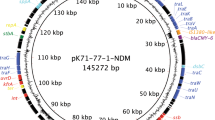Abstract
qnr is an important and recently emerged plasmidic fluoroquinolone resistance gene. Numerous qnr alleles have been detected, but previous studies have suggested that there is little functional divergence among them. We performed phylogenetic analysis of representative qnr alleles and examined the phylogeny for the occurrence of positive selection (dN/dS). Positive selection rarely occurred near the tips of the tree, which confirms that the evolution of qnr alleles has not been driven by functional divergence. Interestingly, we also found evidence of recombination events among qnr alleles that may lack any functional relevance but contribute to the sequence variation of qnr alleles. These findings suggest that drift and recombination may be more important contributors to qnr sequence divergence than selection for new functions.



Similar content being viewed by others
References
Altschul SF, Gish W, Miller W, Myers EW, Lipman DJ (1990) Basic local alignment search tool. J Mol Biol 215:403–410
Altschul SF, Madden TL, Schäffer AA, Zhang J, Zhang Z, Miller W, Lipman DJ (1997) Gapped BLAST and PSI-BLAST: a new generation of protein database search programs. Nucleic Acids Res 25:3389–3402
Amåbile-Cuevas (2003) New antibiotics and new resistance. Am Sci 91:138–149
Barlow M, Hall BG (2002a) Phylogenetic analysis shows that the OXA b-lactamase genes have been on plasmids for millions of years. J Mol Evol 55:314–321
Barlow M, Hall BG (2002b) Predicting evolutionary potential: in vitro evolution accurately reproduces natural evolution of the TEM b-lactamase. Genetics 160:823–832
Bhavnani SM, Hammel JP, Jones RN, Ambrose PG (2005) Relationship between increased levofloxacin use and decreased susceptibility of Streptococcus pneumoniae in the United States. Diagn Microbiol Infect Dis 51:31–37
Blazquez J, Oliver A, Gomez-Gomez JM (2002) Mutation and evolution of antibiotic resistance: antibiotics as promoters of antibiotic resistance? Curr Drug Targets 3:345–349
Canton R, Coque TM (2006) The CTX-M beta-lactamase pandemic. Curr Opin Microbiol 9:466–475
Carattoli A (2001) Importance of integrons in the diffusion of resistance. Vet Res 32:243–259
Cundliffe E (1992) Self-protection mechanisms in antibiotic producers. CIBA Found Symp 171:199–208
Didelot X, Falush D (2007) Inference of bacterial microevolution using multilocus sequence data. Genetics 175:1251–1266
Go ES, Urban C, Burns J, Kreiswirth B, Eisner W, Mariano N, Mosinka-Snipas K, Rahal JJ (1994) Clinical and molecular epidemiology of acinetobacter infections sensitive only to polymyxin B and sulbactam. Lancet 344:1329–1332
Gould IM, MacKenzie FM (2002) Antibiotic exposure as a risk factor for emergence of resistance: the influence of concentration. J Appl Microbiol 92:78S–84S
Hannecart-Pokorni E, Depuydt F, de Wit L, van Bossuyt E, Content J, Vanhoof R (1997) Characterization of the 6′-N-aminoglycoside acetyltransferase gene aac(6′)-Im [corrected] associated with a sulI-type integron. Antimicrob Agents Chemother 41:314–318
Hirakata Y, Srikumar R, Poole K, Gotoh N, Suematsu T, Kohno S, Kamihira S, Hancock RE, Speert DP (2002) Multidrug efflux systems play an important role in the invasiveness of Pseudomonas aeruginosa. J Exp Med 196:109–118
Holmes EC, Worobey M, Rambaut A (1999) Phylogenetic evidence for recombination in dengue virus. Mol Biol Evol 16:405–409
Huelsenbeck JP, Ronquist F (2001) MrBayes: Bayesian inference of phylogeny. Bioinformatics 17:754–755
Jo JT, Brinkman FS, Hancock RE (2003) Aminoglycoside efflux in Pseudomonas aeruginosa: involvement of novel outer membrane proteins. Antimicrob Agents Chemother 47:1101–1111
Kaatz GW, Moudgal VV, Seo SM (2002) Identification and characterization of a novel efflux-related multidrug resistance phenotype in Staphylococcus aureus. J Antimicrob Chemother 50:833–838
Kotra LP, Haddad J, Mobashery S (2000) Aminoglycosides: perspectives on mechanisms of action and resistance and strategies to counter resistance. Antimicrob Agents Chemother 44:3249–3256
Kumar S, Tamura K, Nei M (2004) MEGA3: Integrated software for Molecular Evolutionary Genetics Analysis and sequence alignment. Brief Bioinform 5:150–163
Mau B, Newton M (1997) Phylogenetic inference for binary data on dendrograms using Markov chain Monte Carlo. J Comput Graph Stat 6:122–131
Mau B, Newton M, Larget B (1999) Bayesian phylogenetic inference via Markov chain Monte Carlo methods. Biometrics 55:1–12
Rannala B, Yang ZH (1996) Probability distribution of molecular evolutionary trees: a new method of phylogenetic inference. J Mol Evol 43:304–311
Robicsek A, Jacoby GA, Hooper DC (2006) The worldwide emergence of plasmid-mediated quinolone resistance. Lancet Infect Dis 6:629–640
Tavaré L (1986) Some probabilistic and statistical problems on the analysis of DNA sequences. Lect Math Life Sci 17:57-86
Thompson JD, Gibson TJ, Plewniak F, Jeanmougin F, Higgins DG (1997) The ClustalX windows interface: flexible strategies for multiple sequence alignment aided by quality analysis tools. Nucleic Acids Res 25:4876–4882
Tran JH, Jacoby GA (2002) Mechanism of plasmid-mediated quinolone resistance. Proc Natl Acad Sci USA 99:5638–5642
Tran JH, Jacoby GA, Hooper DC (2005a) Interaction of the plasmid-encoded quinolone resistance protein Qnr with Escherichia coli DNA gyrase. Antimicrob Agents Chemother 49:118–125
Tran JH, Jacoby GA, Hooper DC (2005b) Interaction of the plasmid-encoded quinolone resistance protein QnrA with Escherichia coli topoisomerase IV. Antimicrob Agents Chemother 49:3050–3052
Wu JJ, Ko WC, Tsai SH, Yan JJ (2007) Prevalence of plasmid-mediated quinolone resistance determinants QnrA, QnrB, and QnrS among clinical isolates of Enterobacter cloacae in a Taiwanese hospital. Antimicrob Agents Chemother 51:1223–1227
Yang Z (1998) Likelihood ratio tests for detecting positive selection and application to primate lysozyme evolution. Mol Biol Evol 15:568–573
Acknowledgments
Martin Kreitman made several excellent suggestions for improving the manuscript. This research was funded by UC Merced startup funds.
Author information
Authors and Affiliations
Corresponding author
Rights and permissions
About this article
Cite this article
Baquirin, M.H.C., Barlow, M. Evolution and Recombination of the Plasmidic qnr Alleles. J Mol Evol 67, 103–110 (2008). https://doi.org/10.1007/s00239-008-9131-3
Received:
Revised:
Accepted:
Published:
Issue Date:
DOI: https://doi.org/10.1007/s00239-008-9131-3




